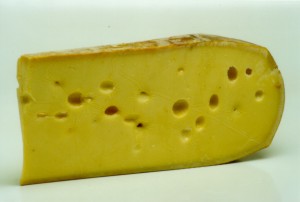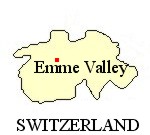
|
|
|||||
The quintessential image of Swiss cheese, Emmental, with its huge marble-sized holes, is now an instantly familiar cheese around the world. First made in the Emme valley near Bern, it has since been adopted by many countries. Embedded in most people's minds as the source of all the mayhem in cartoons such as Tom and Jerry, it has been known to generations of children as "mouse cheese". Probably the largest cheese made, some reach 130kg in weight and measure a metre across. Emmental was first mentioned in 1542, when it was used as payment to compensate the victims of a fire in the town of Langehthal. Initially the holes in the cheese caused scepticism amongst cheese merchants, but soon the cheese became one of Switzerland's most important exports. Although marketed all over the world as Swiss cheese, the genuine Emmental is made only with unpasteurised milk on small farms and dairies. It is one of the so-called 'cooked' cheeses, along with other Swiss cheeses such as Appenzeller and Gruyere. In Switzerland 1000 litres of milk go to make one 80kg cheese. Because of the large quantities of milk used to make just one cheese it is usual for groups of farmers to work together as co-operatives. The evening milk is mixed with the morning milk and warmed in enormous copper vats known as Kessi. Curd cutting is done using a cheese harp. The cut curds are then cooked in the whey, wrapped in cheesecloth and transported to a wooden hoop to drain. Once pressed and turned several times the cheeses are taken to the maturing rooms to ripen. This is when the famous bubbles appear. They are formed by the gas produced by a special culture of bacteria. Many environmental variables determine the size, shape and number of the bubbles. Only the experienced cheese maker is able to determine the exact set of conditions for an even spread of the right sized holes. Swiss cheese-makers have been known to quote "Anyone can make the holes, but only the Swiss can make the cheese". Traditionally , the cheese is matured for 8 to 10 months in cool cellars. The Reservé cheese, however is matured for eighteen months, giving it a fuller and more rounded flavour. The pâte has a distinctive nutty flavour and is creamy yellow in colour, with a delicate aroma. In Switzerland it is combined with Gruyere and Swiss white wine to make fondues. A glass of the same white wine forms a perfect complement. When served on the table, a crisp dry white wine is preferred by most. Our Reservé Emmental is matured as a whole wheel weighing 80kg. Unpasteurised cow's milk is used to make each wheel, giving it a fat content of 45%. Click here or press your 'Back' button to return |
|
|||||
| All articles © www.teddingtoncheese.co.uk | ||||||
